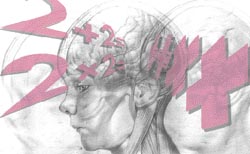A head for figures
 it has been noted that some patients with strokes or brain damage have severe difficulty with language and exact calculations, while their ability to estimate remains intact. Now, a team of French and us researchers has obtained first-hand evidence to prove that two very different modes of brain activity underlie our inborn capacity for mathematics. Besides shedding light on the cognitive basis for one of the hallmark talents of humans, the findings may help psychologists and educators develop new ways to teach arithmetic to children who struggle with numbers.
it has been noted that some patients with strokes or brain damage have severe difficulty with language and exact calculations, while their ability to estimate remains intact. Now, a team of French and us researchers has obtained first-hand evidence to prove that two very different modes of brain activity underlie our inborn capacity for mathematics. Besides shedding light on the cognitive basis for one of the hallmark talents of humans, the findings may help psychologists and educators develop new ways to teach arithmetic to children who struggle with numbers.
Children in countries like India, who are taught in English and not their mother tongue, might benefit from this research. Teaching mathematics is assuming more importance across the world, with Japan leading the race to make its children strong in mathematics.
So, how do people do mental mathematics? Do we need to a have a sense of two eyes and 10 fingers for numerical work? A Swiss psychologist had argued that the ability to do maths with fingers emerges around the age of five years and requires the development of logic skills, such as transient reasoning and putting two sets of objects into one-to-one correspondence. In fact, it has been recognised that infants as young as six months can detect changes in the number of objects in a visual array.
Scientists have long wondered about the extent to which language is required for maths. Despite their lack of language skills, even monkeys and five-month-old infants have some ability to understand numbers. They gape in surprise when they see someone put two dolls behind a screen and then raise the screen to reveal only one doll. Also, the brain centres that process numbers seem to be different for exact and approximate calculations.
Mathematicians, describing what happens in their heads, have long offered clues that at least two modes of thinking
Related Content
- Order of the National Green Tribunal regarding concretization around trees in Jamshedpur, Jharkhand, 07/07/2023
- REDD+ Who does it help?: learnings from Asia and Africa
- Order of the Supreme Court of India regarding deletion of provisions from enactments which cast stigma on the persons who are suffering from leprosy, India, 24/04/2018
- World Water Development Report 2018: nature-based solutions for water
- Notification regarding Amendment in BS VI emission norms
- Brazil Zika outbreak: More babies born with birth defects
